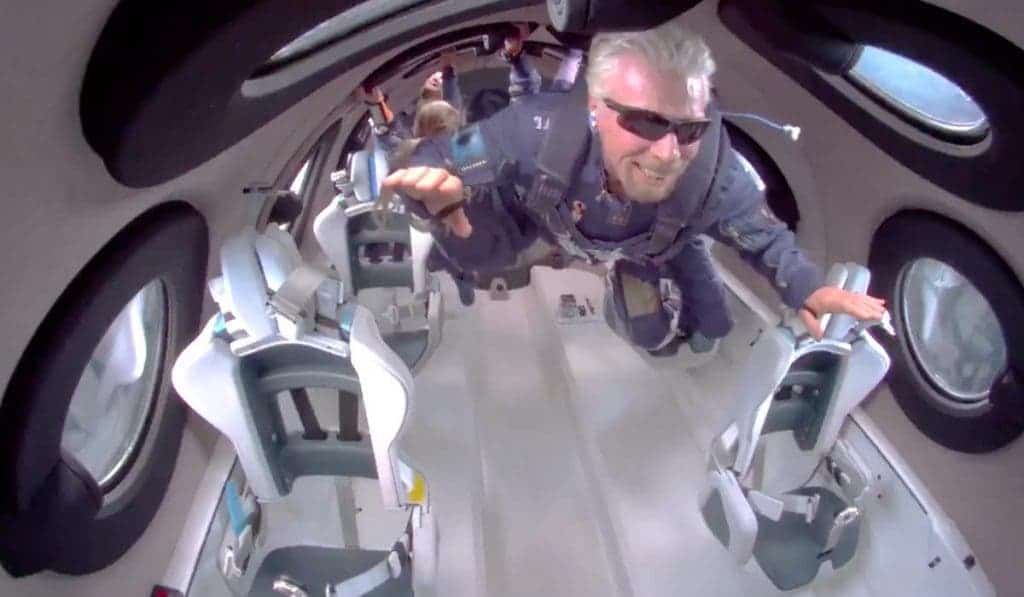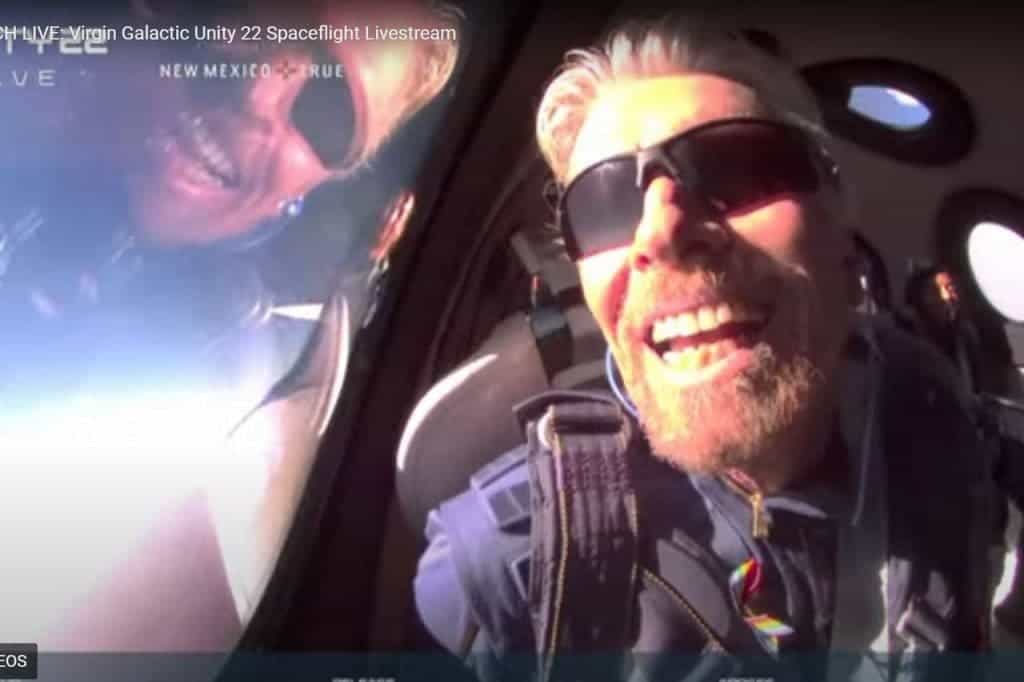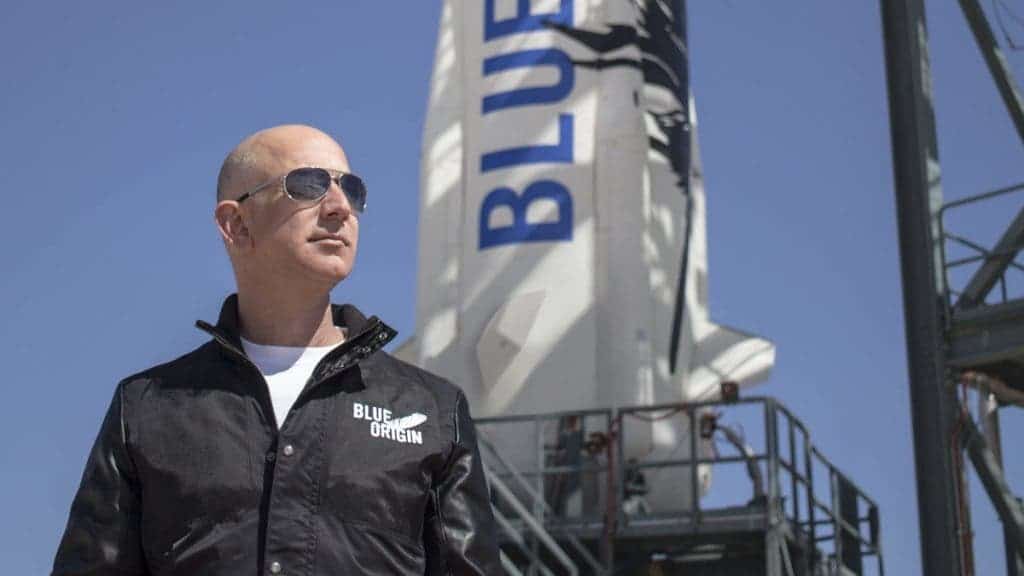With billions spent over more than a decade, a small group of billionaires (just three, actually) are competing against each other to send commercial shuttles into space and eventually capture the large, untapped space tourism market — and one of them has already secured the first trip.

Richard Branson, the founder of Virgin Galactic, outraced fellow billionaires Jeff Bezos and Elon Musk by reaching the edge of space, reaching 55 miles (88km) above the Earth’s surface – after 17 years of development and $1 billion invested. Speaking from the spacecraft, he called the flight “the experience of a lifetime” and said he had dreamt about it since he was a child.
The spacecraft VSS Unity launched above the skies of New Mexico, with two pilots guiding the vehicle that carried Branson and three employees. VSS Unity performed a slow backflip in microgravity and the crew floated around the cabin. The vehicle then returned through the atmosphere in a glide, landing where it took off from. All in all, the flight went exactly as planned.
The Virgin flight
Branson was accompanied by pilots Dave Mackay and Michael Masucci, chief astronaut Beth Moses, operations engineer Colin Bennett and VP of government affairs Sirisha Bandla. VSS Unity can take up to six passengers and two pilots, and the flights won’t go empty anytime soon. The company already has 600 reservations for tickets on future flights, sold between $200,000 and $250,000 each.
“We’re here to make space more accessible to all at all,” Branson said In a press conference after the flight. “The mission statement that I wrote inside my spacesuit was to turn the dream of space travel into a reality for my grandchildren … and for many people who are alive today, for everybody.”
This was the fourth flight to date for Virgin Galactic, its second so far this year, and the first carrying more than one passenger. As well as flying Branson, the company has other goals, as it aims to begin its commercial service in early 2022. The crew members are testing the spacecraft’s cabin and Virgin’s training program, as well as doing research experiments.
After landing back on Earth, Branson announced that Virgin Galactic partnered with sweepstakes company Omaze to offer a chance at two seats on “one of the first commercial Virgin Galactic spaceflights” early next year. The billionaire said he will put on his “Willy Wonka hat” to give the winners a guided tour of Spaceport America.

Branson founded Virgin Galactic in 2004 to fly passengers to space. He started the company to buy spacecraft built by aerospace designer Burt Rutan’s Scaled Composites, which created the SpaceShipOne vehicle. The company then built VSS Unity and began testing it in 2016 – reaching space in 2018 for the first time.
The company got a license expansion last month from the US Federal Aviation Administration, allowing it to fly passengers on future spaceflights. To get the license, Virgin had to complete a verification and validation program for the FAA. The last two regulatory milestones were met with the most recent spaceflight test in May. With all the hurdles passed, Branson was free to rush to the edge of space — and that he did.
Branson wasn’t previously expected to fly on last weekend’s spaceflight, as Virgin had said the company planned to fly the founder on its second to last test flight. But after fellow billionaire Jeff Bezos announced his own plan to fly on his company Blue Origin’s first passenger flight on July 20, Virgin decided to rearrange the schedule to secure an early lead in the “billionaire space race.”
A fast-moving race
Launching ahead of Bezos or Elon Musk, a symbolic win, turned Branson into the first of the billionaire space company founders to ride on his own spacecraft. The three are competing in the realm of suborbital space tourism, with the goal of carrying passengers to the edge of space and experience microgravity for a few minutes. Business hasn’t even started, and it’s already booming.
Global space tourism is projected to reach just $1.7 billion by 2027, according to a report published earlier this year. Virgin already has some big names on its list of confirmed customers, from Ashton Kutcher and Mila Kunis to Justine Bieber and Rihanna – who have allegedly paid the $250,000 ticket for a seat on future flights.

Founded by Bezos in 2000, Blue Origin recently announced its first passenger flight for July 20. Coincidentally or not, Bezos also announced he would step down as CEO of Amazon beforehand. This means Bezos can now be more focused on his space projects without the stress of Amazon operations.
“On July 20th, I will take that journey with my brother,” Bezos wrote in a recent Instagram post. “The greatest adventure, with my best friend. To see the Earth from space, it changes you. It changes your relationship with this planet, with humanity. It’s one Earth. I want to go on this flight because it’s a thing I’ve wanted to do all my life.”
The flight will officially kick off Blue Origin’s space tourism business. Although the company hasn’t yet released details about how one could book tickets (and how much it would cost), there are speculations that the announcements will be coming soon. For now, Bezos is reading for the July 20th flight, with three minutes of weightlessness.
Meanwhile, fellow billionaire Elon Musk is not staying idle. A Galactic spokesman told the Wall Street Journal that Musk had bought a ticket for his own space ride with Virgin Galactic. It’s not clear when he would fly or how extensive is the waiting list. Branson’s company plans to do two more symbolic flights this year and open them to the public in 2022.
Musk, the SpaceX CEO who wants to colonize Mars, and Branson are known to be friends, while Musk and Bezos share a frosty rivalry. Hours before Branson’s flight, Musk had said that he would be there to wish him the best and see him off. He kept his word, posting a photo with the two of them together before Branson’s flight.
Big day ahead. Great to start the morning with a friend. Feeling good, feeling excited, feeling ready.
Watch #Unity22 launch and livestream TODAY at 7:30 am PT | 10:30 am ET | 3:30 pm BST.@virgingalactic @elonmusk https://t.co/1313b4RAKI pic.twitter.com/FRQqrQEbH8
— Richard Branson (@richardbranson) July 11, 2021
A new push for space tourism
It might seem like a new thing, but space tourism actually has a long history. The first space tourist was Dennis Tito, who paid $20 million a ticket. He flew on a Russian spacecraft to the International Space Station (ISS) in April 2001. His net worth is one billion, so it can be argued he beat fellow billionaires Bezos, Branson, and Musk to space by 20 years. But then again, this is a different type of race.
Tito was then followed by other six wealthy private citizens that visited the ISS. The list included the first female space tourist, Iranian-American engineer Anousheh Ansari. Hungarian-American software billionaire Charles Simonyi, who flew twice, and Canadian billionaire Guy Laliberté – the co-founder of the Cirque du Soleil.
But after these first few attempts, orbital space tourism ended abruptly in 2010 due to an increase in the ISS crew size. In the meantime, space entrepreneurs started pursuing the rocket plane concept. The space company Scaled Composites flew in October 2004 an experimental space place to 112 kilometers above Earth’s surface.
The company later merged with Branson’s Virgin Galactic, establishing a waiting list for $250,000 space flights. Branson promised tourism flights as soon as 2008 but there were many setbacks in the way, including a fatal accident. These derailed the timetable but Virgin is now much closer to taking tourists to the edge of space.
But Bezos poked a bit at Branson, alluding that the latter didn’t fly into “true” space. Basically, Virgin Galactic’s flight soared at nearly 300,000 feet (57 miles) in altitude — enough to reach what NASA and the US government defines as the beginning of space (50 miles above sea level), but not enough to reach the Kármán line — the boundary set by the Fédération Aéronautique Internationale. The Kármán line is defined at 100 kilometers or 62 miles above sea level, and Blue Origin pointed out that this is what “96 percent of the world’s population” recognizes as the beginning of outer space. Blue Origin will fly to the Kármán line in subsequent rides, a spokesperson said.
After decades of space tourism being little more than science fiction, it’s finally becoming a reality. With Branson in the lead for now and Bezos and Musk hot on his trail, the billionaire space race is just beginning. Who knows what it will bring us?


